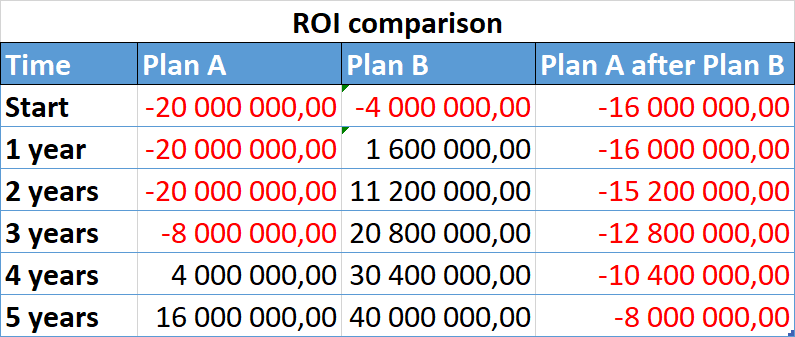Say you have a time consuming, manual process. It takes a team five days (40 work hours per person) to complete each month. The monthly cost to carry out this process is 1 million USD. So that sucks.
PLAN A
Your company decides to automate the entire process, projecting a healthy 1 million USD per month in ROI. That’s a business case that sells itself.
- You figure out that the cost of automating the process is 20 million USD, and will take two years to complete.
- You start the project today, and you’re done in 24 months. 20 months after that you will break even, and start saving 1 million USD per month.
- Total ROI for a five year period: After 44 months you break even, and at the end of the period (after 60 months), you will have saved the company 60–44 = 16 million USD.
Not bad. Not only did we pay down the original 20M investment, we saved another 16.
PLAN B
Let’s say that we figured out a simpler solution. With this solution we aren’t able to fully automate the process, but we are able to reduce the manual work from 40 to 8 hours per person. As a result the cost is also reduced, now down to 200,000USD / month.The cost and time required to put in place this solution? 4 million USD, and roughly 5 months. Time to bring out those calculators again.
- After 5 months, we’ll start saving 0,8M / month.
- This means we pay down the initial investment after a total of 10 months.
- Total ROI after five years: 60–10 = 50 months of saving 0,8M.
Result? A whopping 40 million USD in savings. And that’s with an investment of only 4 million. Even though we didn’t solve the whole problem, the fact that we delivered it sooner made it a much more valuable proposition.
NOW WHAT?
Of course we go with plan B. A smaller investment and much quicker return on investment. But does it still make sense to complete the original project afterwards? Should we do the remaining work to completely automate the process?Let’s say the remaining cost and time is the difference between Plan A and Plan B. So we need 16 million and 20 months to remove the remaining 200,000 USD worth of monthly manual labor.Calculator time! How about that 5 year ROI now?
- After 20 months, we start saving 0,2M per month.
- 60–20 = 40 months times 0,2 M = 8 million in savings.
That’s a bummer. Now we’re still 8 million in the red from our original 16 million investment. From the moment we start our project, it will actually take more than 8 years just to break even. I suspect the company might have other projects that now looks more promising.
IN SUMMARY
Let’s put all those pesky numbers in an Excel sheet.

That was a lot of adding and multiplying, I hope your calculator didn’t burst into flames. The point here is that even though you have a big and complicated problem, a big and complicated solution may not be the best way forward. It’s amazing how many companies would go for Plan A without even giving it a second thought.
The second point, is that this explains why Agile development makes sense. It allows you to solve the problem in small chunks. Even more important, you may serve those chunks to the customer as you go along. As the numbers show, this significantly reduce the cost of delay present in traditional projects. It also enables you to continuously check whether it still makes economic sense to keep going. You know, instead of waiting years to find out if your investment pays off.
Those with some experience in these matters, will have figured out that I’ve played nice with my examples. In the real world, 50% budget overruns are nothing out of the ordinary. That would reduce the 5 year ROI of Plan A from 16 to 6 million, while Plan B would still make 38 million out of its original 40. That’s a shocking difference!
Finally, big and complicated solutions are expensive to maintain – To the extent that you may never break even. Your project may end up simply replacing the original manual labor with the manual labor now needed to keep the automatic system running. No high fives for you. At least it’s a great story to tell at the pub.
The next time you encounter a big and complicated solution, ask yourself if a much smaller one may exist. Even if the small solution doesn’t solve everything the big one does, it may still be the better choice.
(This article originally appeared in @thorbjorn.sigberg’s Medium stream.)